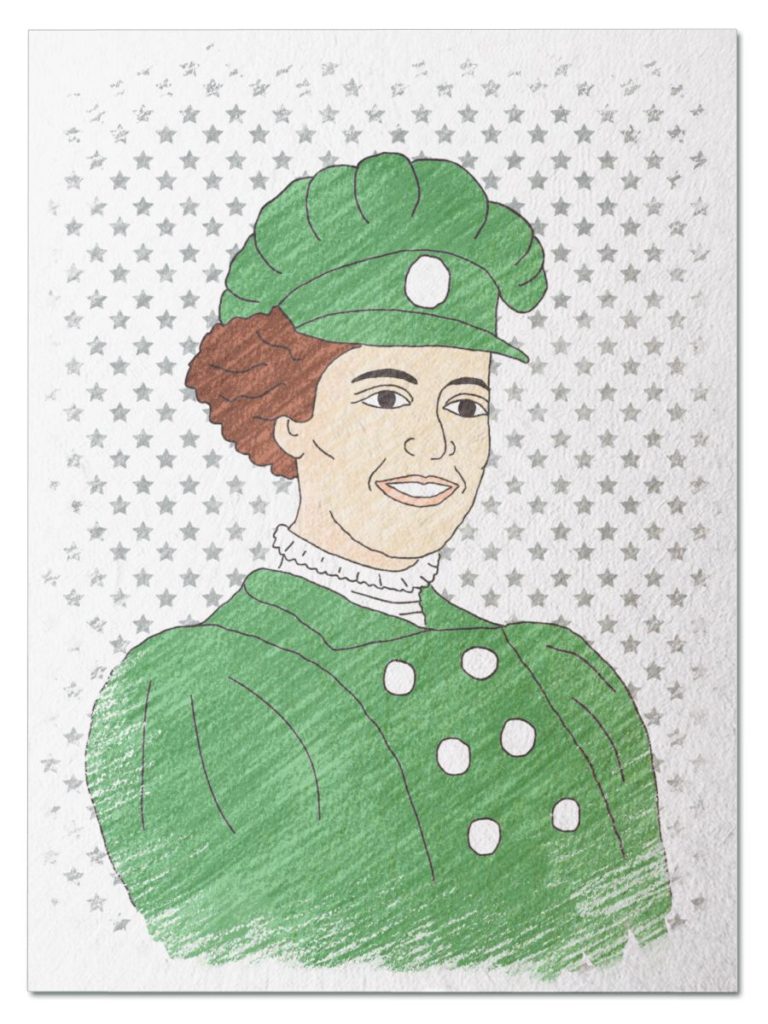
Audacious Adventurer
She embarked on a driving adventure across the United States to prove that a woman could operate an automobile as well as a man. Cars were so new that only 150 miles of her 3,800 mile route were paved – the rest were gravel, dirt, mud, or sand. 59 days (and many mishaps) after leaving Manhattan, she arrived in San Francisco where an excited crowd waited. Climb into a 1909 Maxwell Model 30 automobile and ride along with Alice Ramsey…
Her Ruby Shoe Moment
The Power of the Wand
Her Yellow Brick Road
Brains, Heart & Courage
Glinda’s Gallery
Just the Facts
Her Ruby Shoe Moment
Alice Ramsey stood in the pouring rain on Broadway Street in Manhattan. She was anxious to get going, but had to wait for pictures to be taken. Finally, around 10 a.m. on June 9, 1909, Alice used all her muscle to turn the crank at the front of the car and start the motor. A number of men offered to help, but she wanted to do it on her own. The four women climbed into the car and officially started the road trip of a lifetime.
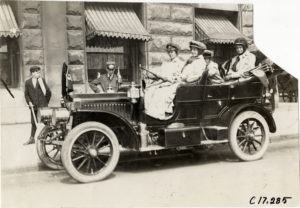
Alice and friends depart from Manhattan. National Automotive History Collection at Detroit Public Library
Alice drove across New York, then west along Lake Erie. They made it to Chicago after two weeks on the road — after some car problems, a hit-and-run accident, and a few wrong turns. While there, Alice packed extra equipment (like a tow rope and shovel) for the next part of their journey. And it was a good decision. There were some tough times ahead.
Everything changed as the women crossed the Mississippi River into Iowa. It rained almost every day and travel was slow — roads were pure mud and creeks became raging rivers. They even slept in the car while waiting for the water to recede so they could cross a bridge.
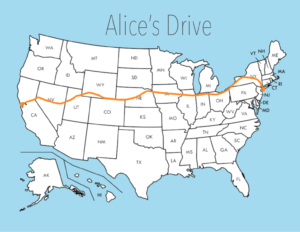 The Maxwell struggled through Iowa — the rear axle broke; the wheels got stuck in potholes; the car stalled; the spark plugs got wet; and the radiator overheated. In fact, Alice had to use their glass toiletry bottles to fill up the radiator with water from the ditch (they called it “Operation Cut-Glass”). Things got so bad that the women escaped by train to Omaha. And only Alice returned to finish the drive across Iowa — the others met her at the Nebraska border.
The Maxwell struggled through Iowa — the rear axle broke; the wheels got stuck in potholes; the car stalled; the spark plugs got wet; and the radiator overheated. In fact, Alice had to use their glass toiletry bottles to fill up the radiator with water from the ditch (they called it “Operation Cut-Glass”). Things got so bad that the women escaped by train to Omaha. And only Alice returned to finish the drive across Iowa — the others met her at the Nebraska border.
Alice followed an old stagecoach trail to cross the Wild West. They needed a guide along the way, since the trail was hard to follow. Sometimes, it was barely a horse path. Other times, it went through private land. It was rough going in the barren desert of Nevada — the car was hard to handle in the sand and the rear axle broke twice because of all the prairie dog holes.
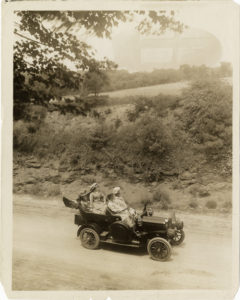
On the road in the Midwest. National Automotive History Collection at Detroit Public Library
The women had a number of adventures in the Wild West. They were stopped by police during the search for a murder suspect. They slept in a hotel that had bedbugs (they slept on the desks in the office). And they found themselves in the middle of a Native American hunting party.
The women finally reached Reno, Nevada at midnight and were surprised to find a crowd waiting to greet them. Then, they took an old wagon trail over the Sierra Nevada mountains, resting the car after every switchback. It was slow going — over 8 hours to cover 70 miles.
After crossing the last mountain range, Alice found it easy driving all the way to the Pacific Ocean. They felt the excitement grow in each town they passed through. Finally, they boarded the ferry in Oakland and were met by a huge crowd in San Francisco. Alice reveled in her accomplishment for a few days before returning home by train.
The Power of the Wand
Alice’s goal was to prove that a woman was capable of driving across the country without the help of any man. She did that, and more. The drive took 59 days to travel 3,800 miles. Only 150 of those miles were paved, however — the rest were gravel, dirt, mud, or sand. It wasn’t an easy journey, but quitting was never an option. Alice knew she could do it.
Alice’s drive was re-enacted by Emily Anderson in 2009, in honor of the 100th anniversary of her road trip. The journey took a few years to plan — Emily’s father loved antique cars and rebuilt a 1909 Maxwell over the course of five years. Then, it took some time for Emily to learn how to drive the antique car, since it was much different from the cars today. The cross-country trip took 31 days, with a number of Emily’s friends and family members joining her along the way.
Today, most girls in America have their driver’s license. But only a few, including Hailie Deegan, have entered the world of car racing. Hailie grew up around motorbikes and dirt paths, since her dad was a motocross champion. Her parents bought her a car when she was 8 years old. She began racing and there was no looking back. In fact, she graduated from high school two years early to focus on race car driving. In 2017, Hailie was the youngest person (and only woman) selected as part of the NASCAR Next Class. And she earned “NASCAR K&N Pro Series West Rookie of the Year” in 2018.
Her Yellow Brick Road
Alice’s cross-country drive was sponsored by the car company, Maxwell-Briscoe. They helped her plan the whole thing, supplied the car, and paid the expenses. In addition, Maxwell-Briscoe agents Alice her along the way, providing assistance if needed and arranging places to spend the night. The company also advertised the adventure, which caused a sensation wherever she stopped.
 Alice recruited three women to join her — her sisters-in-law, Nettie and Maggie (who were a bit older than her) and her friend Hermine (who was only 16 years old). The women were excited for a grand adventure. And she left her family for nearly three months, including her two-year old son.
Alice recruited three women to join her — her sisters-in-law, Nettie and Maggie (who were a bit older than her) and her friend Hermine (who was only 16 years old). The women were excited for a grand adventure. And she left her family for nearly three months, including her two-year old son.
Navigation wasn’t easy on Alice’s road trip. Back then, there were few maps, most roads weren’t marked, and many roads didn’t even have names. So the women had to navigate by landmarks. They also followed telephone poles, in the hopes of eventually reaching a town. Alice relied on the AAA maps and “Blue Book” guides to help them out — unfortunately, many of the directions were based on landmarks that could change (such as the color of a house).
Alice drove a dark green Maxwell Model 30 across the country. And it wasn’t a cushy ride. It had no air conditioning, no heat, no radio, and a cloth roof. It was loud and bumpy. The car had a hand crank to start the motor, oil headlamps, and its top speed was only 40 miles per hour. The rubber tires had no tread, so Alice covered them with chains while traveling on dirt roads. And there was no gas gauge — Alice needed to stop and test the level in the tank periodically.
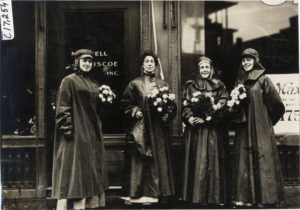
Dressed for the open road. National Automotive History Collection at Detroit Public Library
To prepare for the road trip, Alice had to become a mechanic as well as a driver. She packed a tool chest, extra car parts, tire repair kits, containers of gasoline, and an emergency stash of food. The outside of the car was so loaded up that Alice couldn’t even open the driver door — she had to slide into the drivers seat from the passenger side.
Alice and her companions travelled light because there wasn’t much space in the car. The women could bring only one suitcase each, which were stored on a special luggage rack at the back of the car. While they were on the road, the women were covered in “dusters” and veiled hats to protect themselves from the dirt.
Brains, Heart & Courage
Alice was first exposed to a new-fangled machine, the automobile, in spring of 1908, when a car sped by her buggy and spooked the horse. So her husband thought it may be safer for Alice to have a car herself. He also thought that Alice might enjoy the independence it provided. Mr. Ramsey spent $825 on a red Maxwell roadster for Alice and hired a Maxwell agent to teach her how to drive it.
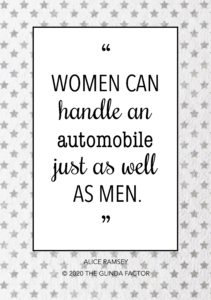 The car was delivered to their house one day, as a surprise for Alice. She spent the summer on the road, driving over 6,000 miles in three months. And she realized that she loved to be behind the wheel.
The car was delivered to their house one day, as a surprise for Alice. She spent the summer on the road, driving over 6,000 miles in three months. And she realized that she loved to be behind the wheel.
Alice decided to enter an endurance drive at the end of the summer. The Montauk Point Run was a 200-mile race from New York City to Montauk, on the tip of Long Island. She was one of the only women to participate in the event. She received a perfect score and earned a bronze medal.
Carl Kesley, from the Maxwell-Briscoe car company, watched the race. And he was impressed with Alice’s driving skills. So he proposed that Maxwell-Briscoe sponsor her on a cross country adventure, as public relations stunt. And the offer was too good for Alice to pass up.
Glinda’s Gallery
Just the Facts
- Alice was born on November 11, 1886 in Hackensack, New Jersey.
- Alice attended two years at Vassar College, a girls college in New York. She quit to get married and never graduated. Back then, only 7% of American women went to college.
- Alice married John Ramsey in 1906 – he was 43 and she was 20 years old.
- Alice lived in Hackensack, New Jersey with her husband, who was a lawyer and Congressman. They had two children, John Jr and Alice.
- Over her lifetime, Alice drove cross country over 30 times. She also took road trips to Europe, crossing 5 of the 6 mountain passes in the Swiss Alps.
- In 1960, AAA named Alice the “Woman Motorist of the Century.” And the Automobile Manufacturers Association named her “First Lady of Automotive Travel” the same year.
- Alice was the first woman to be inducted into the Automotive Hall of Fame on October 17, 2000.
- Alice died on September 10, 1983 in Covina, California at age 96.
Want to Know More?
McConnell, Curt. A Reliable Car and a Woman Who Knows It: the first coast-to-coast auto trips by women, 1899-1916. Jefferson, NC: McFarland & Co., 2000.
Ramsey, Alice with annotation by Gregory Franzwa. Alice’s Drive, republishing “Veil, Duster and Tire Iron.” Tucson: The Patrice Press, 2005.
“Pretty Women Motorists Arrive After Trip Across the Continent.” San Francisco Chronicle, August 7, 1909.
Alice Ramsey”s papers are held at Vassar College.
Ruben, Marina Koestler. “Alice Ramsey’s Historic Cross-Country Drive.” Smithsonian Magazine. June 4, 2009. (https://www.smithsonianmag.com/history/alice-ramseys-historic-cross-country-drive-29114570/)
